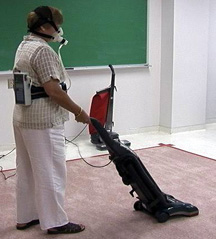For most people, doing housework is a dreaded chore. But for some people with certain health conditions, it can be harmful to their health.
As Joe Norman, Ph.D., and his colleagues worked with patients in a cardiac rehabilitation clinic, some of the patients complained about angina, or chest pain, when vacuuming.
 |
A study participant, M.A. Ray, tests one model of vacuum cleaner. |
“We noticed some people were telling us they had problems vacuuming versus other similar physically demanding activities,” said Dr. Norman, an associate professor in the UNMC School of Allied Health Professions. “They could walk 15 to 30 minutes at a brisk pace but would get angina when they’d vacuum.
“It came up enough periodically to raise the question. It looked like something to look into. We speculated what might be going on was related to the use of the upper extremities.”
So Dr. Norman and his colleagues set out to compare the estimated myocardial oxygen consumption and energy expenditure associated with vacuuming using five different vacuum cleaner models.
Results of the study, of which Dr. Norman was the principal investigator, were published in a recent issue of the American College of Sports Medicine’s Medicine and Science in Sports & Exercise journal and the May issue of the Tufts University Health & Nutrition Letter. The researchers also have presented their findings at a meeting of the American Association of Cardiovascular and Pulmonary Rehabilitation.
Thirty-six healthy women without heart disease between the age 50 and 59 tried out each vacuum cleaner for six minutes with rest in between. Women were used in the study because studies show they have the primary responsibility for housekeeping, even after a cardiac event.
Measurements of heart rate, blood pressure, oxygen consumption data and rating of perceived exertion were measured in the study participants before and after vacuuming. They tested the energy required to operate five models of vacuums – three upright and two canister styles. They included self-propelled upright, a canister style with a power-head spinning brush, a lightweight upright, heavyweight upright and a compact canister.
Angina occurs when the heart muscle (myocardium) doesn’t get as much blood – and hence as much oxygen — as it needs. It’s also a sign that someone is at increased risk of heart attack, cardiac arrest and sudden cardiac death.
Dr. Norman, who also specializes in cardiovascular physiology, said it’s important that workload on the heart doesn’t exceed the oxygen supply to the heart. If the amount of oxygen needed for the heart muscle to perform tasks is out of sync with the amount of oxygen being supplied, angina occurs. Vacuuming requires the work of both the upper and lower extremities.
Researchers found the best model to reduce the demand on the heart was the self propelled, which is least demanding for someone with a heart disorder.
“We found the vacuum cleaner model with some type of power assistance has significant impact on lowering the demand on the heart,” Dr. Norman said. “These types of features should be taken into account when making recommendations for patients with limited capacity or those needing to limit physiological stress due to a disease state.”
He said the second best vacuum they found was the canister model with spinning brushes.
Based on their findings, researchers hypothesize that if individuals with cardiovascular disease could walk on a level treadmill at 2 mph without angina, they may also be able to use a power assisted vacuum model without experiencing angina. However, researchers say if people experience angina while using power assisted models, or while walking on the level at 2 mph, they may need to avoid vacuuming.
Researchers also said personal preference for a certain vacuum does not correlate with reduced energy demand. “Unfortunately, you can’t just go try out a vacuum cleaner,” Dr. Norman said. “You have to look to see if it has power assistance — self-propelled. That’s more important than having a certain preference for a vacuum cleaner.”